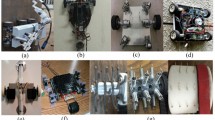Abstract
A virtual window has been applied for real-time path planning of a mobile robot in the presence of unknown obstacles. The path planner projects a vertical plane ahead of the robot, and calculations of the space ahead and any intersections are done with respect to this window. A radial basis function is used to decipher the information on the window and to relay it to the planner. Using this technique, path planning through an unknown space can be performed which avoids collisions with obstacles present in the space. A simple method of defining an obstacle or many obstacles is also proposed by using rectangles of different sizes.
Similar content being viewed by others
References
Balding, N. W.: Real-time path planning for robot arms, PhD Thesis, University of Durham, UK, 1987.
Bowyer, A. and Woodwark, J.: A programmer's Geometry, Butterworths, London, 1983.
Hou, Edwin S. H. and Zheng, D.: Mobile robot path planning based on hierarchical hexagonal decomposition and artificial potential fields, J. of Robotic Systems 11(7) (1994), 605–614.
Kamon, I. and Rivlin, E.: Sensory-based motion planning with global proofs, IEEE Trans. on Robotics and Automation 13(6) (1997), 609–615.
Luke, N.: The investigation of a method for use in the simulation of variable speed time delay processes within MATLAB, Development and Testing Report 1, Department of Automatic Control and Systems Engineering, University of Sheffield, 1998.
Khatib, O.: Real-time obstacle avoidance for manipulators and mobile robots, Int. J. Robotic Res. 5(1) (1986), 91–98.
Lumelski, V. J.: Path-planning strategies for a point mobile automaton moving amidst obstacles of arbitrary shape, Algorithmica 2 (1987), 403–430.
McCarthy, W. E.: A fuzzy-logic controller for an autonomous vehicle operating in an unknown environment, MSc Thesis Dept. of Mechanical Engineering, University of Nevada, USA, 1994.
Mortenson, M. E.: Computer Graphics: An Introduction to the Mathematics and Geometry, Heinemann Newnes, Oxford, 1989.
Ramírez-Serrano, A. and Boumedine, M.: Real-time navigation in unknown environments using fuzzy logic and ultrasonic sensing, in: Proc. of the IEEE Int. Symp. on Intelligent Control, Dearborn, MI, September 15–18, 1996, pp. 26–30.
Rao, D. H.: Neural network in robotics and control: some perspectives, in: Int. Conf. on Industrial Automation and Control, 1995, pp. 451–456.
Skewis, T. and Lumelsky, V.: Experiments with amobile robot operating in a cluttered unknown environment, J. of Robotic Systems 11(4) (1994), 281–300.
Zhang, M., Peng, S., and Meng, Q.: Neural network and fuzzy logic techniques based collision avoidance for a mobile robot, Robotica 15 (1997), 627–632.
Zhu, D. and Latombe, J.-C.: New heuristic algorithms for efficient hierarchical path planning, IEEE Trans. on Robotics and Automation 7(1) (1991), 9–20.
Author information
Authors and Affiliations
Rights and permissions
About this article
Cite this article
Mansor, M.A., Morris, A.S. Path Planning in Unknown Environment With Obstacles Using Virtual Window. Journal of Intelligent and Robotic Systems 24, 235–251 (1999). https://doi.org/10.1023/A:1008047425796
Issue Date:
DOI: https://doi.org/10.1023/A:1008047425796




